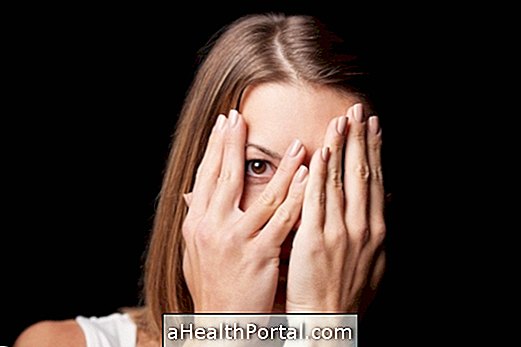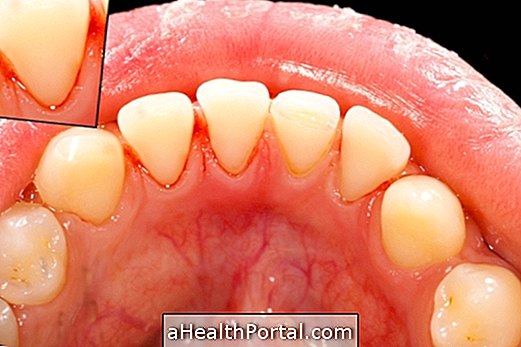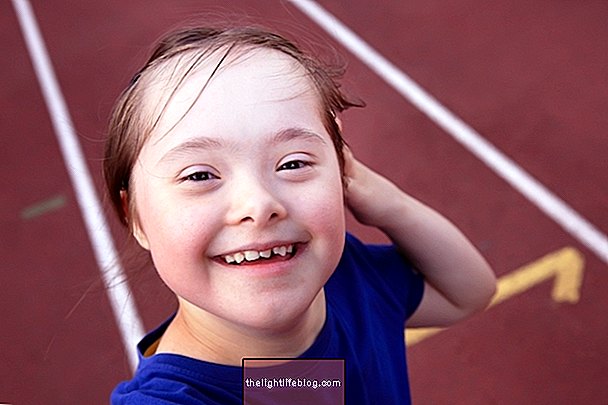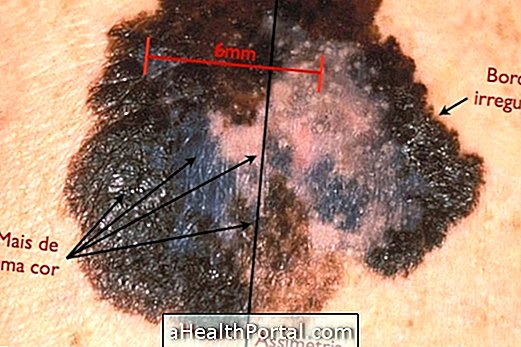Mental disorders are dysfunctions in the functioning of the mind, which can affect anyone and at any age and are usually triggered by complex central nervous system changes.
There are several types of mental disorders, which are classified into types, and some of the most common include those related to anxiety, depression, eating, personality or movements, for example. Next, we will talk about the main mental disorders in the population, and at the end there is a complete list of the existing types.
1. Anxiety
Anxiety disorders are very common, present in about 1 in 4 people who go to the doctor. They are characterized by a feeling of discomfort, tension, fear or bad feeling, which are very unpleasant and are usually provoked by the anticipation of a danger or something unknown.
The most common forms of anxiety are generalized anxiety, panic syndrome and phobias, and are very harmful both by affecting the person's social and emotional life and by causing uncomfortable symptoms such as palpitation, cold sweat, tremors, lack of air, feeling of suffocation, tingling or chills, for example, and by the greater risk of developing depression or addictions by alcohol and medicines.
- What to do : Psychotherapy is recommended, as well as follow-up with the psychiatrist who, in some cases, may indicate the use of medicines that relieve symptoms, such as antidepressants or anxiolytics. It is also oriented towards physical activity and, moreover, it may be useful to invest in natural methods or leisure activities such as meditation, dance or yoga, for example. Learn more about ways to treat anxiety.

2. Depression
About 15% of people have depression at some point in their lives. Depression is defined as a depressed mood that persists for more than 2 weeks, with sadness and loss of interest or pleasure in activities, and may be accompanied by signs and symptoms such as irritability, insomnia or excessive sleep, apathy, weight loss, or weight gain, lack of energy or difficulty concentrating, for example. Understand how to know if it is sadness or depression.
- What to do : to treat depression, follow-up with the psychiatrist is indicated, which will indicate the treatment according to the severity of the condition and the symptoms presented. The main way to treat depression is by combining psychotherapy and using antidepressant medications, which include Sertraline, Amitriptyline, or Venlafaxine, for example.
3. Schizophrenia
Schizophrenia is the main psychotic disorder, characterized as a syndrome that causes disorders of language, thought, perception, social activity, affection and will. It is most common in young people in late adolescence, although it may arise over other ages, and some of the most common signs and symptoms are hallucinations, behavioral changes, delusions, disorganized thinking, changes in movement or superficial affection, for example .
Although the exact cause of schizophrenia is not known, it is known to be related to genetic changes that cause defects in the brain's neurotransmitter systems, which may be hereditary. Find out what the main types of schizophrenia are and how to confirm it.
- What to do : Psychiatric follow-up is required, which will indicate the use of antipsychotic medications, such as Risperidone, Quetiapine, Clozapine and Olanzapine, for example. In addition, family counseling and follow-up with other health care professionals, such as psychology, occupational therapy, and nutrition, for example, are essential if the treatment is to be completely effective.
4. Eating Disorders
Anorexia nervosa is characterized by intentional weight loss caused by refusal to feed, distortion of one's image and fear of gaining weight. Bulimia, however, consists of eating large amounts of food and then trying to eliminate the calories from harmful forms, such as by inducing vomiting, using laxatives, strenuous exercise, or prolonged fasting.
Eating disorders are more common in young people, and have been increasingly frequent by the culture of aesthetic appreciation. Although Anorexia and Bulimia are the most known eating disorders, other problems related to eating include Ortorexia, which is the excessive worry about eating healthy foods, Vigorexia, which is the obsession with the muscular body, or binge eating, for example. Find out what are the main eating disorders.
- What to do : There is no simple treatment to cure eating disorders, requiring psychiatric, psychological and nutritional treatment, and medications are usually indicated only in cases of associated diseases such as anxiety or depression. Support groups and counseling can be good ways to supplement treatment and get good results.
Post Traumatic Stress
Post-traumatic stress is anxiety that arises after being exposed to some traumatic situation, such as an assault, a death threat or loss of a loved one, for example. Generally, the affected person relives persistently what happened with memories or dreams, and presents intense anxiety and psychological suffering. Check out how to know if it is post traumatic stress.
- What to do : The treatment is done with psychotherapy, and the psychiatrist may also indicate medications, such as antidepressants or anxiolytics to relieve the symptoms.

5. Somatization
Somatization is a disorder in which the person presents multiple physical complaints, referring to various organs of the body, but which are not explained by any clinical change. Usually they are people who constantly go to the doctor with many complaints, and in the medical evaluation, physical examination and conducting exams, nothing is detected.
In most cases, people with somatization disorder have anxiety and mood disorders, and may have impulsivity. When in addition to feeling the person comes to simulate or intentionally provoke symptoms, the disease happens to be called a factitious disorder.
- What to do : Psychiatric and psychological counseling is necessary so that the person can ease the symptoms. Remedies like antidepressants or anxiolytics may be needed in some cases. Learn more about somatization and psychosomatic diseases.
6. Bipolar Disorder
Bipolar disorder is the psychiatric disorder that causes unpredictable mood swings, ranging from depression, which consists of sadness and discouragement, and mania, impulsivity and overly extroverted trait.
- What to do : The treatment is usually done with mood stabilizing medications, such as lithium carbonate, which should be recommended by the psychiatrist. Understand how this disease is identified and treated.
7. Obsessive-compulsive disorder
Also known as OCD, this disorder causes obsessive and compulsive thoughts that impair the daily activity of the person, such as exaggeration in cleanliness, obsession with washing hands, need for symmetry or impulsiveness for accumulating objects, for example.
- What to do : The treatment for obsessive-compulsive disorder is psychiatrist-led, with the ingestion of antidepressant medications such as Clomipramine, Paroxetine, Fluoxetine or Sertraline, and it is also recommended to do cognitive-behavioral therapy. Learn more details on how to identify and treat this disease.
List of mental disorders
According to the Diagnostic and Statistical Manual of Mental Disorders (DSM-5), the list of principal includes:
- Anxiety Disorder, such as panic syndrome, generalized anxiety, stress or phobia;
- Bipolar disorder, which alternates periods of depression and periods of mania;
- Depressive Disorders, in which there are various types of depression;
- Obsessive-compulsive disorder ;
- Psychotic Disorders, such as schizophrenia or delusional disorder;
- Eating Disorders, such as anorexia or bulimia;
- Post-Traumatic Stress Disorder ;
- Personality disorders, such as the paranoid, atypical, boderline, strionic or narcissistic types, for example;
- Substance-related disorders, such as illicit drugs, alcohol, drugs or cigarettes, for example;
- Neurocognitive disorders, such as delirium, Alzheimer's or other dementias;
- Neurodevelopmental Disorder, such as intellectual disabilities, communication disorders, autism, attention deficit hyperactivity disorder or changes in movement;
- Somatization disorders, in which the patient presents physical complaints for no apparent reason;
- Dissociative Disorder, such as Depersonalization / Derealization Disorder or dissociative amnesia;
- Gender Dysphoria, related to sexual development;
- Disruptive Disorders, Impulse Control and Conduct Disorders, such as Kleptomania, Pyromania or Explosive Disorder;
- Sexual dysfunctions, such as premature or delayed ejaculation;
- Sleep-wake disorder, such as insomnia, hypersomnia, or narcolepsy;
- Elimination Disorder, such as urinary or fecal incontinence;
- Paraphilic disorders related to sexual desire;
- Movement disorders related to drug effects.
There are also several other types of disorders, such as those related to social, educational, professional or economic problems, for example.




















